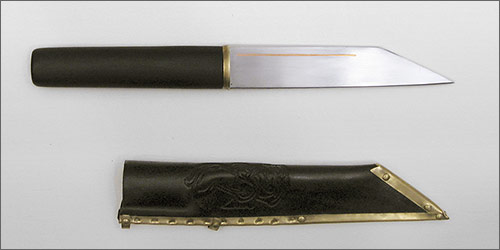
 |
|
|
Elchon's Workshop Broken Back Seax
A hands-on review by Chad Arnow The seax served many purposes throughout its long history. In use for several centuries, it came in many forms, from small knives suited for everyday use to sword-sized weapons, with much in between. Always a single-edged weapon, it could be relatively plain or richly decorated. One popular form, the broken-back seax, is often thought to be an English (Anglo-Saxon) one, but it has been found on the European continent and in significant enough numbers there to show that it was not uncommon. The name broken-back derives from the back edge of the blade which angles sharply down to the tip: the back edge usually angles away from the cutting edge at the blade's base, widening the blade until a sharp angle moves it toward the point. This makes for an acute point suitable for stabbing. Overview Michal Plezia of Elchon's Workshop is a reenactor and smith from Poland. Though the 15th century is his reenactment group's focus, Michal's interests are not confined to that era. He makes weapons and armour from many time periods including modern knife forms. Michal uses a hammer and a gas forge to begin his pieces, not power hammers and milling machines of any kind. They are finished with hand tools and handheld power tools. Though he mainly makes short blades, like knives and daggers, and armour, he plans to expand into making sword-length blades. This seax was not made on commission, but rather as a study of the form. The steel blade features inlays of three different metals mated to a grenadilla wood grip with a brass bolster. The scabbard was formed of heavy, stiff leather dyed with a single coat of black dye. The scabbard was then rubbed to bring out some brown highlights to better match the grip.  Measurements and Specifications:
Replica created by Elchon's Workshop of Poland. Handling Characteristics This seax feels comfortable in the hand and ready for a variety of tasks. Indeed, its size and balance make it well-suited to everyday tasks. The blade's spine is nearly a quarter of an inch thick at the base which gives it a little more authority in the hand than a thinner blade would carry. This thickness also ensures that it could handle heavy-duty work. The grip is comfortable and its shape makes it easy to tell where the edge is. Fit and Finish Michael Plezia has crafted a seax that is a nice blend of austere and ornamented. The grenadilla wood grip is very simple and is finished with a brass bolster. The blade is decorated on each side with a line of inlaid metal: copper on one side and twisted silver and brass on the other. The inlays are ground flush with the blade. The finish is nicely done overall. The bolster could mate with the grip a little better as there are some very slight gaps at the junction of the two parts. The blade is polished to a satin finish that should be easy to maintain. A scabbard completes the package nicely. It is formed of heavy leather which has been dyed, hand-rubbed, and then treated with beeswax and oil. A zoomorphic design has been tooled into the leather. The scabbard's fittings, including two suspension rings, are of brass stamped with geometric designs. The seax locks securely into the scabbard. Saxes are depicted in period art worn at the front of the belt at an angle. When this seax is worn in that fashion with the scabbard's design facing out, the hilt points to the left hand. Conclusion This is a nice offering: simple, attractive, and functional. Michal has created a seax with a lot of class that would fit a variety of personas. I look forward to seeing more from the workbench at Elchon's Workshop. About the Author Chad Arnow is a classical musician from the greater Cincinnati area and has had an interest in military history for many years. Though his collecting tends to focus on European weapons and armour of the High Middle Ages, he enjoys swords, knives and armour from many eras. Acknowledgements Photographer: Chad Arnow |